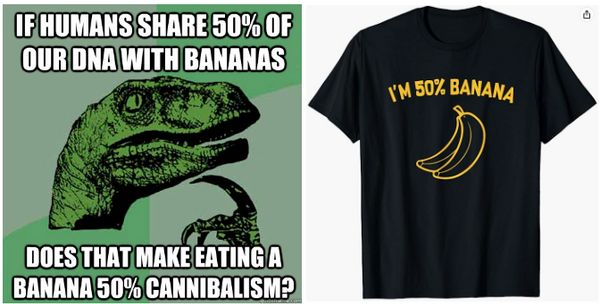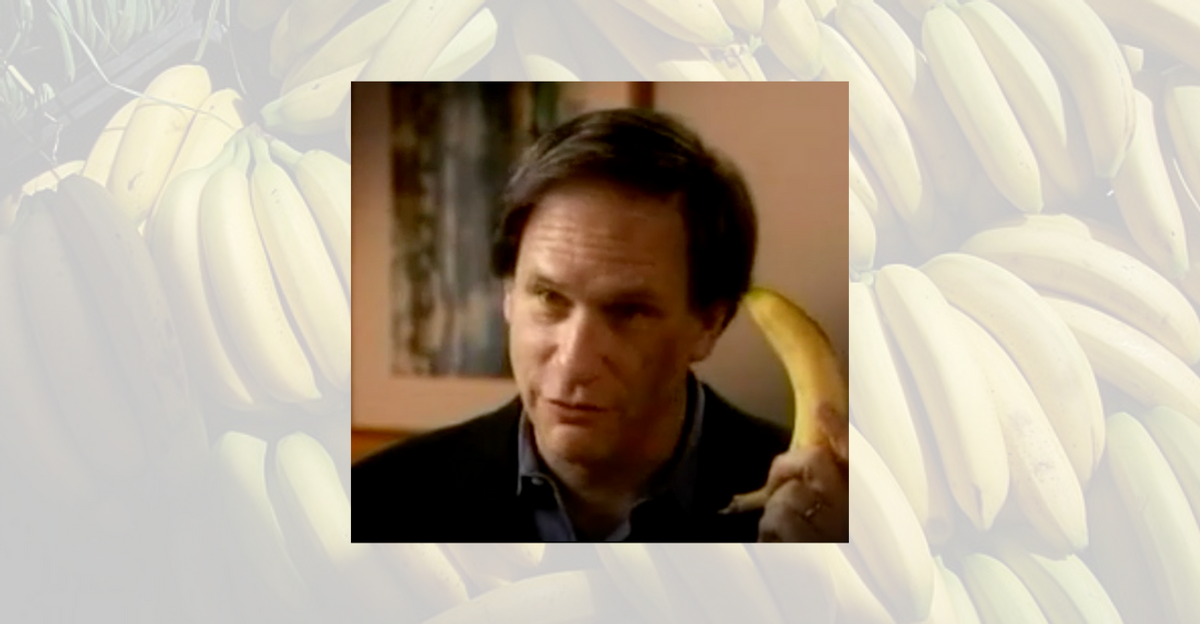Claims regarding 50% genetic similarity, while likely overstated, are based on a comparison of similarly functioning genes, not the specific DNA sequences that make up the human genome.
A popular "science fact" on the internet dating back decades contains some variation of the assertion that, from a genetic standpoint, a human and a banana are 50% similar. There are memes and shirts, too:

On June 28, 2023, the claim appeared on the feed of the potentially misnamed Twitter account @Fact, which purports to provide "Interesting facts about life" to its 3.1 million followers:
Humans share 50% of their DNA with bananas.
— Fact (@Fact) June 28, 2023
Though commonly repeated, there is no scenario in which "humans and bananas share 50% of their DNA" could be interpreted as a factual statement. Part of the problem is terminology. The earliest iteration of the claim that Snopes can identify dates to a 2001 PBS Nova episode about the Human Genome Project. In that episode, however, the phrasing is different. Instead of an assertion of shared DNA, the discussion — with MIT scientist Eric Lander — regards sharing the same genes:

(PBS Nova)
As Mark Peplow of the Royal Science Media Centre wrote in a comment to New Scientist back in 2003, genetic similarity depends on how it is defined. A broad definition (genes that perform the same function) and a narrow definition (identical DNA sequences) make for wildly different comparisons:
Apparently "modern inhabitants of Paris… share an average of 50 per cent of their genes with people from Baghdad." Compare this with the frequently cited statistic: "Humans share 50 per cent of their genes with a banana." Does this mean that the residents of Baghdad are bananas?
This is a common source of confusion, and no wonder. There are many different ways of comparing genetic similarity. The often quoted fact that people are genetically nearly identical to chimps, for example, comes from the analysis of amino acids coded for by just a couple of genes that we share with chimps. 98 per cent of those amino acids are the same.
The 50 percent figure for people and bananas roughly means that half of our genes have counterparts in bananas. For example, both of us have some kind of gene that codes for cell growth, though these aren't necessarily made up of the same DNA sequences.
Fifty percent, even by that broader definition, is a potentially suspect figure, and it does not appear to come from any published research. In December 2020, computational biologist Natasha Glover wrote a blog post detailing her efforts to track down the source of the rumor and evaluate its scientific validity. Her methods were designed to get the highest possible similarity, but the highest result she achieved was only 25%:
To understand how much of the genome is conserved between banana and human, I will look at proteins because it's the feature most likely to be conserved [i.e. unchanged by evolution] between human and banana. This is to be as permissive as possible in attempts to give the benefit of the doubt to the 50% meme.
Now the question is, how do we compare all the proteins in one species to all the proteins in another species and see which ones "match", i.e. descended from a common ancestral gene? This is a fundamental problem important for studying evolution. Orthologs are the term we use for genes in different species that started diverging due to a speciation event, i.e. "corresponding" genes between species.
This is where our lab's [The Dessimoz Lab at the University of Lausanne in Switzerland] expertise comes in: we maintain Orthologous Matrix, which is a method and database for finding orthologs between many species. [...] All the orthology-inference methods tested show a maximum of 25% of human genes to be orthologous to banana.
More to the point of the claim, however, is what percent of DNA is "identical" in both human and banana. Based on comparisons of whole genome pairs between humans and zebrafish (which are much more closely related to humans than bananas), Glover argued, the shared DNA figure would be well below 1%.
Because no definition of genetic similarity provides results close to 50%, and because the claim refers to DNA sequence similarity and not more broad definitions of genetic similarity, the claim is False.

